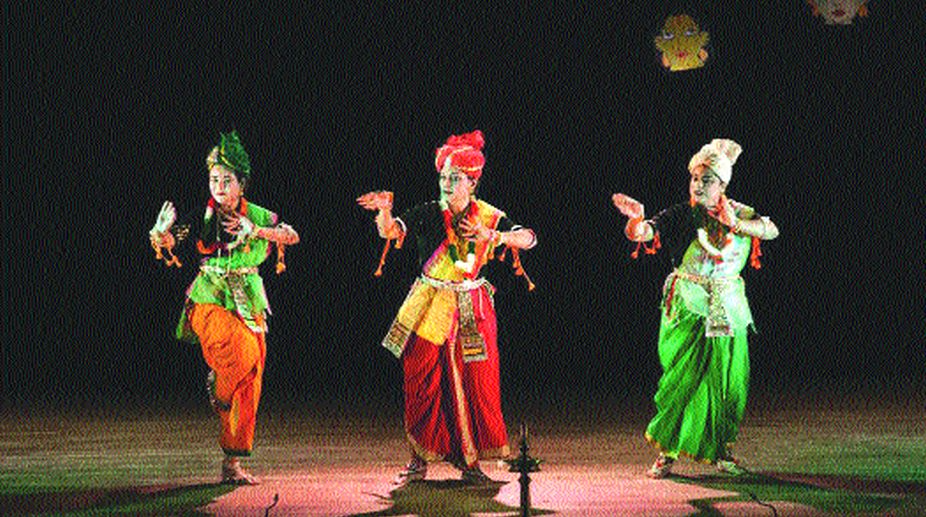Ranbir pulls off ‘Shamshera’ fight sequence inspired by Kalaripayattu
Ranbir Kapoor learned the art of Kalaripayattu, a traditional martial art form for one of the fighting sequences for his upcoming film 'Shamshera'.

Katha Angika was a festival of dance and theatre, which celebrated five genres of Indian classical dance. The festival was rounded off with Kalaripayattu — an Indian martial art from the hoary past. In fact it finds mention in Sangam literature much of which has been lost. But let’s take a look at the four classical dance styles that were presented.
Kerala was culturally enriched by the great Chera monarch Kulasekhara Perumal, who was also one of the 12 Alwar saints of the south. The state has a rich tradition of dance drama on mythological themes, especially those depicting Vishnu taking the form of Mohini with enticing abhinaya. Thus was born Mohiniattam. The devadasis who settled down in Kerala naturally accepted the concept of Mohini. A few pieces of the style established Priyadarshini Ghosh and Mohana Iyer, of the Natyanova Dance Company, as innovative choreographers. The duo joined by their troupe members Ranu, Sreeradha, Sushmita, Saheli and Srijaini commenced with the genuflection to Ganapati, the remover of obstacles. His various attributes were described in a slow-paced way. The piece was in ragam Hamsadhwani and talam chempata while the music was by Leela Omcherry. Mukhachalam, a piece showcasing the pure nritta of Mohiniattam in in raga Malika and tala malika — a composition of Kavalam Narayana Panikkar — captured the circular and semi-circular movements the genre’s uniqueness. Mangala Shloka, in ragam Bageshri and talam marma, in praise of Lord Nataraja, was replete with the typical Kerala style of rhythm reaching a crescendo.
Moving on, Sreyashi Dey presented Shiva-Shakti in the Odissi style. The style is known for its grace, sculpture-like stances and intense lyricism in its movements. She showcased two opposites — one with form and the other formless, energy and consciousness in the cosmos as a whole as well as in every individual.
The first hymn from Shiva Panchaka, described Lord Shiva who is the most mercurial God of the Hindu Trinity. The power and energy of Shiva as portrayed by Dey in the rich style of her mentor Guru Gangadhar Pradhan was commendable. Her huge chaukas and pronounced bhangas were pleasing to behold. The piece vividly and reverentially described the physical attributes of Lord Shiva. Choreography was by Guru Gangadhar Pradhan.
Advertisement
On the other hand, Mahakali Stuti was in praise Mahakali or the Dark Mother. She liberates, and along with her counterpart Lord Shiva, grants moksha and is famed as the destroyer of ego. Dey evocatively described her outer appearance and beautifully etched the Goddess’ multiple forms. Literature, stories of mythology and the great Indian epics are generally the traditional source grounds of classical dance and therefore its value will never to be lost as long as they are performed on stage. The choreography of Mahakali was by Guru Bichitrananda Swain.
Odissi dancer Arpita Venkatesh’s Navagraha paid respects to Navagraha (the nine planets) with the Navagraha Stotra of Rishi Vyasa in a neat choreographic work with her students. Venkatesh shone like a jewel with the impeccable form acquired from her guru Alok Kanungo, who has been recently awarded the Sangeet Natak Akademi Award. With the help of a well-reherased work, Venkatesh was cynosure of all eyes.
Next up, Poushali Chatterjee, carefully nurtured in the Guru Bipin Singh style of Manipuri dance, delivered Vasanta Raas with her group. Chatterjee got the audience involved by playing with colours in Khilata Radha Gopi Sangh. The playful Krishna tackled the whole lot of gopis alone with sprinklers filled with colours. It was a good idea to use shredded yellow marigold rather than actual gulal. It made cleaning the stage for the next performer a lot easier. The rendition of Tanuum, which is a pure dance piece, gave the audience a glimpse of Manipuri. However, to be at her best, Chatterjee should catch up on her practice.
Thereafter, one found their way to Kathak. Sanjay Bhattacharya started his repertoire with Rambhajan, which was rather unusual. Tulsi Das’ Sri Ramchandra Bhajman sung in Yaman Kalyan raga and teora tala was soothing and appealed to the listening pleasure of the audience. In the nrityang taal, Rudra was used to show the students’ taalim. Teen taal, which is the most sought after taal of all Kathakas and which spells either success or doom, was presented in a pleasing manner. Toras, tukras, tehais, amad, padahant and chakradhars were executed with as much ease and élan as young aspiring dancers are capable of. The last piece was by Bhattacharya himself. A good performer and teacher, he would do better as a performer with a well-tuned physique.
Sutradhar Arko Mukhopadhyay is a theatre person to whom launching an evening of dance was child’s play. He was a natural stage actor as was aptly clear when he spoke. He is presently a Kalaripayattu trainee in Kerala under the mentorship of Assan Ajith Kumar. A group of Kalaripayattu artists, Ajith Kumar, Maruthi Mama Chikilsa and Kalari Sangham came all the way from Kerala to present their art at Gyan Manch. Their wielding of the weapons and close contact technique were commendable.
Sreyashi Dey with her admirable academic record of teaching at Michigan University is the founder-president of Akshara, which is a platform to create, perform and promote the arts from India both in their traditional forms and in more dynamic and contemporary expressions. She is also the president and artistic director of Shristi, which specialises in performance and preservation of Indian classical dance. Katha Angika was her presentation in Kolkata to fulfill her pledge to the arts.
Advertisement